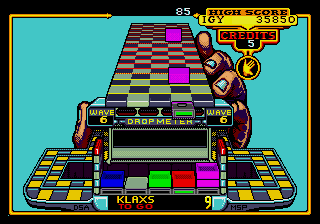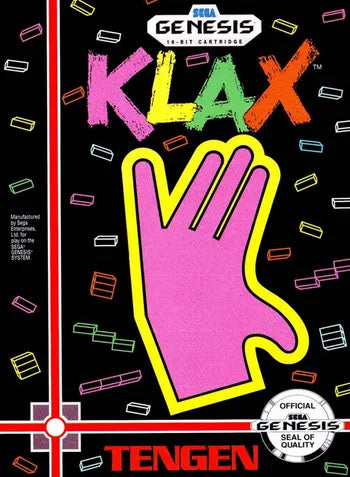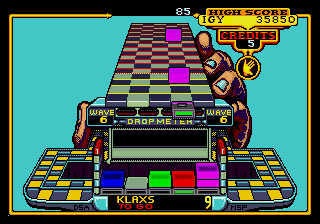TENGEN
Klax SEGA Genesis Video Game
Klax SEGA Genesis Video Game
Couldn't load pickup availability
Platform: SEGA Genesis / Mega Drive
Complete Unit: Case, Cartridge & Manual
Klax is a puzzle video game released in arcades in 1990 by Atari Games while Namco distributed the game in Japanese markets. It was designed by Dave Akers and Mark Stephen Pierce. The object is to catch colored blocks tumbling down a machine and arrange them in colored rows and patterns to make them disappear. Klax was originally published as a coin-opfollow-up to Tetris, about which Atari Games was in a legal dispute at the time.
Controls consist of a four-position joystick and a button. The player controls a small paddle at the lower end of a constantly running conveyor belt. Using the joystick, the player can move the paddle left or right to catch tiles in various colors as they advance down the conveyor. Below the paddle is a well that can hold up to 25 tiles in five columns of five; pressing the button causes the topmost tile on the paddle to fall directly downward and into the well, as long as that column is not full. The goal is to form "Klaxes", or unbroken horizontal/vertical/diagonal lines containing three tiles of the same color. Doing so awards points and causes those tiles to disappear, allowing any tiles above them to fall toward the bottom of the well. Bonus points are awarded for completing multiple Klaxes with a single tile (including lines of four or five matching tiles) and for Klaxes formed by the falling of already-placed tiles.
The paddle can hold up to five tiles at any given moment. The player is penalized with one "drop" whenever a tile falls off the conveyor without being caught or while the paddle is full. Pushing up on the joystick will flip the topmost tile on the paddle a short distance up the conveyor, while pulling down accelerates the motion of the tiles.
The game consists of 100 waves, presented as 20 groups of five waves each. At the start of the game and after every fifth wave, the drop meter is cleared and the player is presented with three options of which wave to play next; choosing a later wave awards bonus points and allows more drops. Each wave has an objective that must be reached, such as making a set number of Klaxes, scoring a certain number of points, or surviving a set number of tiles. At the end of a wave, bonus points are awarded for each tile still on the conveyor and paddle and for each empty space in the well.
The game ends when the player either exhausts the available drops, completely fills the well, or finishes all 100 waves.




